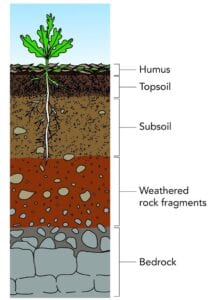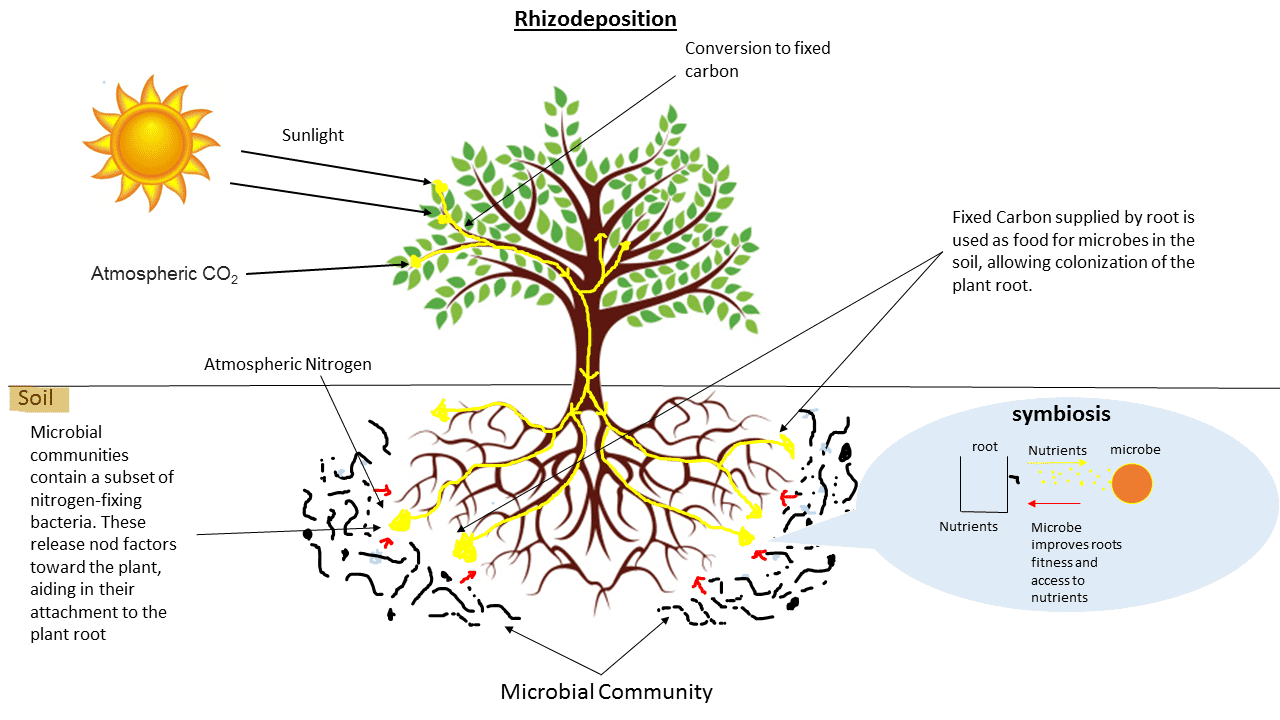Day 9: Soil Part I—Assessing And Building Your Foundation
Dear Student,
Congratulations on completing the first chapter of this course on the basics of farming… now, for the following eight lessons, we’ll dig a little deeper (pun intended). Starting today, I’ll be teaching you about planting and growing, and it all starts underground…
“Essentially, all life depends upon the soil … There can be no life without soil and no soil without life; they have evolved together.”
–Charles E. Kellogg, USDA Yearbook of Agriculture, 1938
Soil, in conjunction with adequate water supply, is the most important asset on most farms. It is—quite literally—the foundation of your homestead, and the productivity of your garden is directly related to the health of your soil.
 Soil consists of three main layers:
Soil consists of three main layers:
- Topsoil: Made of several components, including clay, small stones, sand, humus* (pronounced hy-oomis), un-rotted organic matter, and silt.
- Subsoil
- Parent material or bedrock
*Humus is the well-rotted organic matter that binds soil together and holds most of the available nutrients and water in the earth (like compost). Three inches of humus can hold an inch of water. Over an acre area, each inch of water held in the soil equates to over 27,000 gallons. In fact, the Latin name for man, homo, derived from humus, the stuff of life in the soil.
In an organic garden, plants don’t take nutrients from the soil itself but from the microorganisms (bacteria, fungi, nematodes, and protozoa) that mine nutrients from the soil. So the secret a healthy, balanced garden lies in creating an ideal habitat—feeding the soil that feeds the microorganisms that feed your plants.
“Our most important job as vegetable gardeners is to feed and sustain soil life, often called the soil food web, beginning with the microbes. If we do this, our plants will thrive, we’ll grow nutritious, healthy food, and our soil conditions will get better each year. This is what is meant by the adage ”Feed the soil not the plants.
–Jane Shellenberger, “Organic Gardener’s Companion: Growing Vegetables in the West”
Understanding The Basic Science
In a process called rhizodeposition, plants’ root hairs exchange nutrients with the microorganisms in the soil, symbiotically exchanging these for starch that they release. The nematodes and protozoa feed on the bacteria and fungi in the soil and excrete waste that the plant feeds on.
 This exchange happens on a molecular level, as plant roots have negatively charged ions and organisms have a positive charge, allowing the exchange of nutrients to flow like electricity between charged points.
This exchange happens on a molecular level, as plant roots have negatively charged ions and organisms have a positive charge, allowing the exchange of nutrients to flow like electricity between charged points.
There are over 50 million species of bacteria and another 50 million of fungi in soil—but this count represents the mere 1% that we have classified. Despite our meager knowledge, we know how important they are to a healthy biosphere.
Organic soil is truly alive, and correct soil management can increase earth year after year, as productivity and fertility increase in tandem.
“While it is relatively easy to recognize the perennial grasses and seed-eating sparrows as characteristic of meadows, the ecosystems exist in their fullest sense underground. What we see aboveground is only the outer margin of an ecosystem that explodes in intricacy and life below.”
–Amy Seidl, “Early Spring: An Ecologist and Her Children Wake to a Warming World”
Macroorganisms also have a role to play. Worms, termites, and other soil-dwelling critters feed on organic matter and microorganisms and improve soil quality. Having macroorganisms in your soil is a great indicator of its good health.
Different types of plants work in conjunction with different kinds of microorganisms, and it pays to have at least a basic understanding of this relationship. In a nutshell:
- Perennial ecosystems (like trees, shrubs, and plants that are not annuals, i.e., do not have to be replanted every year) thrive on fungal activity, and fungi feed on rotting wood.
- Annual ecosystems (that must be replanted every year) thrive on bacterial activity, and bacteria feed on non-wood-based organic matter.
“A tree’s most important means of staying connected to other trees is a “wood wide web” of soil fungi that connects vegetation in an intimate network that allows the sharing of an enormous amount of information and goods.”
–Tim Flannery, “The Hidden Life of Trees: What They Feel, How They Communicate – Discoveries from a Secret World”
Compost is made up of well-rotted organic matter and is partly a colloidal substance (made of particles less than 15 microns thick). It makes a superb soil amendment that microorganisms love.
PH is the measure of hydrogen ions in the soil, expressed as a measure of acidity or alkalinity on a scale of 1 to 14, with neutral being 7, the median. Each point on the scale is 10 times more concentrated than the previous, so pH 5 is 10 times less acidic than pH 4. Most vegetables prefer pH of around 6.5/7 (very slightly acid).
PH test kits are available from any garden supply store and are cheap and easy to use. If your soil is too acidic, add some alkaline materials like lime, dolomite, or gypsum; if too alkaline, add some acidic substance, like sulfur.
“Man takes root at his feet, and at best he is no more than a potted plant in his house or carriage till he has established communication with the soil by the loving and magnetic touch of his soles to it.”
–John Burroughs
The Curse Of Modern Industrial Agriculture
Most modern chemical fertilizers (NPKs) are made of three main ingredients: nitrogen (N) phosphorus (P) and potassium (K). However, healthy soils also require 12 minor elements and 25 trace elements for healthy plant growth.
Chemical fertilizers come in the form of “salts” that dissolve in contact with water. When plants come into contact with this enhanced water they drink it, thus absorbing the nutrients.
“The soil is the great connector of lives, the source and destination of all. It is the healer and restorer and resurrector, by which disease passes into health, age into youth, death into life. Without proper care for it we can have no community, because without proper care for it we can have no life.”
–Wendell Berry
Most modern, industrial-scale agriculture cultivates annual crops in a series of ultimately destructive steps:
- Ploughing: This shreds the soil, allowing clay in the soil to wash down to eventually form a clay pan beneath the soil, raising its acidity and often causing drainage problems.
- Chemical fertilization: By adding chemical NPK, plants’ root hairs are not needed (so they don’t grow), which means soil organisms don’t get fed, and the soil ultimately loses its structure.
Due to the high salt levels in the chemical fertilizer, plants drink more of it in an attempt to balance the salinity, making them weak from over-hydration and lack of trace nutrients.
Weak plants attract pests, as their natural defenses are reduced.
- Pesticides: Because the plants are now plagued by pests, farmers spray them with pesticides, which promptly kill any soil microorganisms that may have survived to this point. This leads to the collapse of the soil, and soil death.
- Salt pan: The fertilizer salts wash down through the soil to create a salt pan or “salt-crete” under the dead soil, preventing any new roots from growing through it.
- Herbicides: Weeds, nature’s natural healers, sense the soil destruction and jump up to try de-compact and rejuvenate the soil. The farmer responds by spraying herbicides, killing all plant life.
- Biocide: The eventual result is biocide (death of all living things in a biosphere) and erosion of the dead soil into drains and waterways. This takes longer in richer, deeper soils but will eventually happen in most cases of modern industrial farming.
- Move on and repeat: The farmer is left with no choice by to move to another farm… or borrow from the bank until he goes bankrupt.
Remember the Dust Bowl (or, rather, the history lesson and photos you’ve seen of it)? The Dirty Thirties were caused by large-scale farming of the American plain soil—largely from ploughing alone, without any of the subsequent steps… and that was before industrial agriculture really got going.
“…Don’t forget; mostly, it’s not the fault of the tree to produce bitter fruits. Sometimes, the soil determines that; blame the source! Deal with the soil! Don’t deal with the tree! Other trees are there that the same soil can influence!”
–Israelmore Ayivor
The Solution Is Organic
Since 1950, planet Earth has lost half of her arable land’s topsoil to erosion or salt panning.
This is a catastrophic loss to mankind.
People often claim organic farming costs too much or takes too much effort, but if growing conventionally is a recipe for losing your farm to the bank or having to move your operation to an area that chemical agriculture has not destroyed (yet), then organic farming (properly conducted) is without a doubt cheaper and easier in the long run.
There are organic solutions to any problem nature might present to your farm. Soil additives, like concentrated dried kelp powder, for example, provide the full range of minerals needed for healthy soil.
“Although the surface of our planet is two-thirds water, we call it the Earth. We say we are earthlings, not waterlings. Our blood is closer to seawater than our bones to soil, but that’s no matter. The sea is the cradle we all rocked out of, but it’s to dust that we go. From the time that water invented us, we began to seek out dirt. The further we separate ourselves from the dirt, the further we separate ourselves from ourselves. Alienation is a disease of the unsoiled.”
–Tom Robbins, “Another Roadside Attraction”
